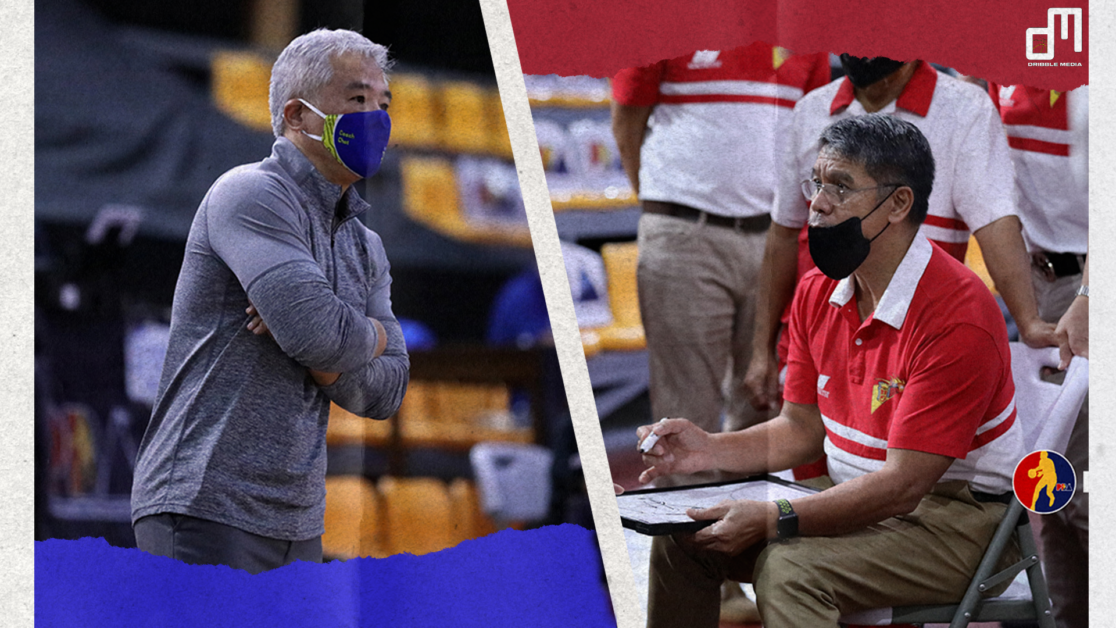A series of brilliant counters and adjustments highlighted the recent semifinals battle between the TNT Tropang Giga and the San Miguel Beermen.

There is a tendency to underrate, if not outright disparage, coaches in the PBA. Faults are assigned without trying to look closely at what they were actually trying to do. Instead, we just assume they didn’t do their jobs and that’s that. Our coaches don’t necessarily try to reinvent the wheel nor do they experiment with lineups as much as they probably should, but they still have a wealth of tactical knowledge that is miles ahead of what the vast majority of us possess. Basically, they know ball.
The recently-concluded semifinals series between the San Miguel Beermen and the TNT Tropang Giga was one of the more interesting tactical battles in recent memory. The games alternated between the two teams through counters, and counters to counters (and counters to counters to counters). Both teams (and coaches) had their moments, but in the end Chot Reyes and his Tropang Giga took the series. Honestly, the seven games were probably not enough to consider either of them as the definitively better team. If the series was replayed multiple times, both teams could have won.
A Quick Look at the Rosters
TNT is more known for being a team with dynamite offensive talent and dynamic scorers in Jayson Castro, Mikey Williams, and RR Pogoy, but their success during the elimination round was brought about by their terrific defense. A strong defensive cast led by Ryan Reyes, Kib Montalbo, Brian Heruela, and Kelly Williams held opposing teams to an offensive rating of 88.9 (10.5 points below league average). They were a slightly below-average shooting team, but they took more shots from beyond the arc than most teams, which aided their spacing.
San Miguel has the established names. They have the greatest PBA player of all-time in June Mar Fajardo, a former Most Valuable Player in Arwind Santos, a former Defensive Player of the Year in Chris Ross, a former Finals MVP in Alex Cabagnot, the best shot creator in the league in Terrence Romeo, one of (if not) the best shooters in the league in Marcio Lassiter, and a pair of former first overall picks in Mo Tautuaa and CJ Perez. But what they didn’t have is ideal roster construction. All of these guys are terrific players, but there isn’t a ton of synergy between their respective skills. San Miguel isn’t a paper tiger, but the roster wasn’t constructed in a way that would maximize the talent of their collection of stars. Even then, they were a formidable team who owned the distinction of producing the best offense in the PBA during the elimination rounds.
A Series Overview
The series was very close. The point differential between both teams was only 15 points (or 2.1 points per game). San Miguel was more efficient in terms of shooting (52.7 TS% vs 51.9 TS% for TNT), but this was driven by a much higher free throw attempt rate (32.0% vs 25.4% for TNT). San Miguel’s offense was pretty close to its league-best production as their offensive rating only fell off by 1.4 (106.8 to 105.4). This would still be the best offense in the PBA if we compare it to the league’s elimination round production. Considering that TNT was by far the best defensive team in the PBA, offense was generally not the problem for them.
The cause for concern was with their defense. Historically, San Miguel has been an offensive juggernaut with a passable to borderline bad defense. That was the case again this season. Their defensive rating of 99.9 in the elimination round was slightly below league average. Their defensive woes were made very clear by a TNT team that came alive at the right time. The Tropang Giga’s offensive rating went up by 7.4 points, which is a mark that is even higher than the Beermen’s offensive rating in the elimination round.
It’s safe to say that the key area for both teams would be San Miguel’s halfcourt defense. For them, their defense has always been a relative weakness. The key to winning would probably be doing a good enough job defensively and cruising to a victory on the back of their offense. For TNT, they needed to exploit the mismatches presented to them by the defense. San Miguel is loaded with a hoard of offensive talent and they need to find a way to be able to keep up. For that reason (and to prevent this from being even longer than it is), we’ll go into a deep dive on the development of tactics between the two teams on a game-by-game basis.
Game 1: The One Where They Did the Usual
In Game 1, the Beermen did their usual thing. They had June Mar Fajardo play in drop (with the occasional show) and hope for the best. For this to be effective, they need the guard defender at the point-of-attack (POA) to be able to recover quick enough to return to the play. This means that Chris Ross would have to be on his A-game on defense. Ross did well on defense and held Mikey Williams to seven points on 12 attempts from the field.
But the problem with relying on Chris Ross to usher up your defense is that he can’t be everywhere. After discovering that Ross can’t duplicate himself and that his main job was to shadow Mikey Williams, he deployed Castro and Pogoy alongside the rookie. With Castro taking on a lesser-skilled POA defender, he carved San Miguel to the tune of 16 points in just 23 minutes of action. Pogoy then took advantage of June Mar backpedaling and his defender scrambling, as he showed good flashes as a scorer, a passer, and a pick-and-roll (PnR) ball-handler.
The typical defensive strategy for the Beermen worked decently and to be honest, it’s their offense that let them down in this one. But the thing to take away from Game 1 is that this set the baseline for both teams’ strategy. As much as possible, San Miguel doesn’t want June Mar to venture into the perimeter and TNT wants to exploit this.
Game 2: The One Where SMB Used the Zone
In Game 2, things seemed to continue where they left off. June Mar dropped and Pogoy took the floater and the midrange shot that the drop coverage conceded. The Beermen ended up down eight after the first quarter.
Then, it happened. Leo Austria made the adjustment and the Beermen transitioned into a 2-3 matchup zone. TNT has been threatening them with the prospect of Erram shooting which they eventually had to address. San Miguel did not want June Mar in the perimeter and a zone would mean that someone else would take the responsibility of closing out on Erram while Fajardo stays in the paint. However, the most important reason for shifting to a zone was to prevent penetrations. TNT scored 16 points in the paint in the opening period. A zone would, ideally, prevent penetration and dare the Tropang Giga to take more jumpers. In the first quarter, TNT only took seven jumpers, and that number jumped to 12 in the second quarter.
Austria knew that the zone isn’t really a scheme you should go to for the whole game so he decided to go back to the usual man-to-man defense early in the third quarter. This backfired pretty quickly. With the inside being more open and Erram back to being defended by June Mar, TNT managed to rustle up a 19-point lead.
With a potential blowout at hand, Austria brought the zone back out and it worked. The penetration again ran to a screeching halt and TNT couldn’t make them pay from the outside. The SMB offense went to work and the comeback was completed. TNT only had two points in the paint during the final quarter and only made five of their 20 shots from outside the paint.
Game 3: The One Where Chot Broke the Zone
With the zone fresh in both teams’ minds, the Beermen opted to start with man defense and it was not pretty for San Miguel. With Fajardo still giving Erram space, TNT let him take charge. He came through the gates firing and scored nine points on three consecutive triples.
With Erram heating up and TNT’s offense humming, San Miguel had no choice but to bring the zone back. But this time, Chot Reyes was ready. TNT chopped the zone up methodically and exploited its weaknesses with precision. It is important to highlight two of the ways they attacked the zone. First, they attacked the corners. In a 2-3 zone, the corners are usually left to the pair of forwards stationed somewhere in between the corner and the low block. Because of their positioning, a pass to the corner would typically result in a closeout.
In this play, Mikey Williams was stationed at the corner. When the ball reached him, Mo Tautuaa had to make a closeout. As soon as Tautuaa came toward him, Williams started to drive. Tautuaa can’t change directions in time to keep up with Williams and it resulted in a floater. A good closeout should both defend a jumper and be prepared for a drive. But being able to do both is hard so having players who can shoot from the outside and can also put the ball on the floor is very valuable.
The other way that TNT attacked the zone is by changing the zone’s shape. San Miguel seemed to have been in a 2-3 match-up zone. A match-up zone is sort of a mixture of both man and zone principles. You are assigned a zone to guard, but you still have to guard your man. This means that depending on what the other team does, it can look like a 3-2, a 2-1-2, or any other shape. By forcing SMB to constantly react to passes being zipped from all over the court, the match-up zone responds and changes shape depending on where the ball is. But the players on the floor can only do so much before a gap opens or they break formation.
In this next clip, it takes two passes to break the formation. Ryan Reyes drove and kicked it out to Castro. Castro found Williams in the corner. Either Tautuaa or Romeo (probably Romeo) made a mistake and both of them closed out on Williams. Williams faked and took Tautuaa out of the play completely and then he found Castro wide open. Ross landed flat footed on the closeout which forced Arwind to help. CJ recognized Arwind helping and moved in to guard Dave Marcelo (note that this would be Tautuaa’s man, but he’s still out of the play as this is all happening). With only four men on defense in the play, Reyes was open and Castro made the right read.
Chot Reyes came prepared with a plan in this game and his team executed it to perfection. When facing San Miguel’s man-to-man defense, take advantage of Fajardo’s limitations. When in a zone, swing the ball around until they break.
Game 4: The One Where June Mar Stepped Out
If you believe that Leo Austria doesn’t coach or implies that he doesn’t play a real hand in San Miguel’s success, this game is required viewing. Let’s do a brief recap: the Beermen were down 2-1, their primary man-to-man scheme was dead by the second game, and their zone defense was ripped to shreds in the third game. In short, both Plan A and Plan B are gone. If you think Austria doesn’t know how basketball works, this is the game where you expect him to wave the white flag. Instead, SMB registered the most dominant performance of the series.
First, they stopped hiding Fajardo and let him guard Erram on the perimeter. They saw that TNT was hurting them by taking advantage of Fajardo staying inside and giving Erram too much space. Thus, the counter was “do not give Erram space”. Why did this work? Erram isn’t an on-ball threat in the perimeter. He can knock down jumpers fine, but he’s not going to blow by his man with the ball in his hand (even if his man is Fajardo). Prior to his injury, Erram only had three points to his name and was -11 for the game.
The other reason this worked was because of Arwind Santos. Despite being 40 years old, he is still one of the more athletic players in the PBA. His wingspan also doesn’t recede with age. He might not be as quick or spry as he once was, but he’s more than capable of acting as a secondary rim protector in an All-Filipino Conference. With Fajardo on the perimeter, it became more important that Santos was in the backline to protect the rim. Otherwise, the paint would be wide open. There really isn’t much to explain here, but just enjoy this Arwind compilation.
Instead of sticking to the tried formula and the usual emergency button, San Miguel adjusted and levelled the series. From “How do we hide June Mar on defense?”, the question became “Why should we hide June Mar in the first place?”. Though they ended up losing in seven, this adjustment was my particular favorite. It just shows that PBA coaches might not be the inflexible basketball cavemen that many perceive them to be.
Game 5: The One Where Kelly Came Back
Now, there is a new conundrum for Chot. They’re guarding Erram now, but wasn’t this what they wanted? Didn’t they want Fajardo stepping out so that they could attack the paint? They got what they wanted, but Santos thrived as a help defender and secondary rim protector. How do they prevent him from helping?
The answer was surprisingly simple. You can’t help on defense if you’re the person they’re targeting at the point of attack. With Fajardo being more aggressive in guarding bigs in the perimeter, he isn’t going to be as deep in the paint as he used to be. Santos can’t come swoop in and block shots by helping if he’s the one getting attacked.
This was fun and all, but things got even more fun when Chot inserted Ryan Reyes at power forward. Ryan Reyes is 6’2 but he’s a decent shooter, playmaker, and ball handler. He’s also a phenomenal defender. But, he isn’t the first name that comes to mind when you think “power forward”. This was a legitimate small-ball lineup. It wasn’t a typical Filipino small ball where it’s small because the players happen to be small. This is small ball in the sense that you use small players that are skilled as opposed to bigger players who can use less. In this game, the small lineup consisted of four players from a combination of Jayson Castro, Mikey Williams, Kib Montalbo, Brian Heruela, RR Pogoy, and Ryan Reyes, along with either Kelly Williams or JP Erram. The small-ball lineup was +17 in a game where TNT won by 20.
The same principle remained with this lineup — pull Fajardo outside and attack Santos. It’s ridiculously fun that a lineup where the power forward is 6’2 and the core concept is attacking a former DPOY worked in the playoffs. They attacked him as they would a big man in a pick-and-roll. When he cheated off his man to help inside, a kick-out pass was promptly given. He often looked unsure of what to do against the smaller and more skilled TNT players. He couldn’t decide whether to help inside or stay on his man, and in the end, he was usually left stuck in no man’s land. The hero in the previous game became the target in the next. The playoffs are cruel like that. I am not one to cite a single game plus/minus, but Santos was -23 in a 20-point game. The film suggests that there’s something to that number.
Speaking of elder statesmen in the PBA, Kelly Williams came back after missing the first four games of the series. The 39-year-old added another wrinkle for the Beermen to worry about. Unlike Erram, Kelly can be a threat with the ball in hand. He is a skilled passer and initiator. In the three games he played, he was TNT’s third-best passer after Castro and Mikey based on our passer rating metrics. Having Fajardo high up could be problematic against a guy who can actually punish his slow feet and pass the ball to open spaces inside.
Eventually, the Beermen couldn’t find an answer quick enough and resorted to the usual emergency button: the good old 2-3 zone. This time, TNT decided to dismantle it in a different way. Instead of swinging it around, they primarily employed the use of ball screens to move the ball handler forward. This works because, in essence, the zone acts as a conservative drop coverage with the three defenders inside staying in their assigned areas. TNT knows what to do against conservative defenses and they just ate the zone up. When the zone shrinks or changes shape to prevent penetration, shooters become open and cutters are free to come inside the blind spots. TNT, in particular Castro, abused this relentlessly.
Kelly was also really good at rifling in passes to the man in the dunker’s spot. Putting a man in the dunker’s spot against the zone serves to take advantage of a blind spot. When the defenders inside see a driver, they tend to ball watch. The player in the dunker’s spot can then simply cut inside for an easy layup. Kelly used his height and passing ability to accurately pick apart the zone.
Kelly’s return and a delightful foray into small ball led to a win for TNT. They showed San Miguel that the zone is a death wish and added wrinkles in their attack to prevent Santos from shoring up their rim protection. To be honest, it seemed like the Beermen had no options left.
Game 6: The One That is Still Kind of Confusing
In an elimination game, the Beermen’s counters have all been countered. That means it’s time to counter again. First, let’s look at what they did with Kelly Williams. The reason why Fajardo can’t meet Kelly at the perimeter is because he has the foot speed and dribbling ability to take him off the dribble and make him pay.
The obvious counter here is to treat him like a non-shooter until he can prove that he isn’t. When he drove to the rim, June Mar kept his distance. Kelly isn’t going to posterize him and he’s never had the best touch around the basket. That was enough to neutralize his penetration. San Miguel either made Fajardo or Tautuaa sag off and focus on protecting the paint or just pawned off the responsibility to a smaller defender when Kelly was on the perimeter.
TNT still employed the same “Attack Santos” principles in the early stages of the game and wheeled out the small ball unit too. It generally went well early on and looked similar to what happened in the previous game.
So, how do you counteract a small-ball defense? You punish them for daring to put tiny people on your bigs. How did San Miguel do this? They used Tautuaa and Fajardo together. Fajardo and Tautuaa as a pairing isn’t new, but it discouraged TNT from trying to go small for extended periods of time. Tautuaa is nimble enough to be decent at guarding the perimeter and he’s too big and hefty for Ryan Reyes and Brian Heruela to guard. Fajardo already requires at least two people to slow down. Adding Tautuaa makes a world of difference against a height deficient lineup. That duo is hard to defend even if you have adequate size, so a smaller team would face a lot of difficulty against them.
In this case, Austria’s counter wasn’t a defensive counter. It’s a counter on offense to make the opposing team sub out a lineup that’s giving his defense trouble. Pretty clever, if not intuitive.
But one of the biggest reasons San Miguel won wasn’t because of their own doing, rather it’s because of TNT’s own strategy. In an effort to grab second chance points, Troy Rosario was stationed at the dunker’s spot against man-to-man defenses. In lineups with Kelly (who SMB was ignoring on the perimeter) or in possessions where Erram wasn’t spacing the floor, this produced terrible spacing and a clogged paint. Troy inside resulted in two bigs in the paint for San Miguel, which greatly affected TNT’s ability to score inside.
In this game, the Beermen forced Kelly to prove himself as a shooter, dissuaded the small ball by playing big when the lineup was fielded, and benefited from TNT’s self-created poor spacing. However, it still felt like TNT was in the driver’s seat as they seemed to do everything right in the fourth and successfully trotted out the small ball with Heruela and Erram acting as the bigs.
Game 7: The One That Sent TNT to the Finals
Let it be known first that Game 7 was anticlimactic and ended up being a game of who had more available bodies. That being said, it’s funny that it ended up being tactically similar to the first few games of the series.
In the previous game, the Beermen experienced success in having their defenders camp in the paint. This might have prompted them to go back to their Plan A that employed drop coverage and sagging off shooters. At first, there were decent results as they ended up leading at the end of the opening quarter.
Things changed quickly. TNT started hitting their threes and San Miguel’s players started getting injured.
With Tautuaa and Romeo getting hurt, they lost two of their most important players on offense. Tautuaa led them in scoring for a few games and was scoring 12.3 points on a great 66.5 TS% in the series. Romeo was their second-leading scorer at 15.6 points on an acceptable 51.5 TS%. CJ Perez was able to play around 25 minutes, but he was hobbled for a good chunk of that time. Perez was their leading scorer when Romeo was nursing an injury in the elimination round.
Due to this, Fajardo’s gargantuan offensive load got even bigger. This meant that on both ends of the floor, Fajardo (who just got back from a broken leg) became the Beermen’s most important player (read: only chance to win). At first, he wasn’t all too bad and was playing the drop as well as he could within his limitations (read: not too great, but good enough).
The SMB offense stagnated and pretty much keeled over in the middle quarters. The Beermen tried showing Fajardo in the pick-and-roll and even revived the zone for one last go, but neither trick did enough to slow TNT enough. But it must be stressed that the offense was worse than the defense.
Fajardo played 40 minutes in this game and in the previous one. Before this series, he only played 34 minutes at most. He was constantly targeted on defense and he was tasked to lift his team’s offense at the same time. Eventually, his offensive load took a huge toll on his defense and this opened the floodgates. They could have asked June Mar to be as aggressive on defense as he was in the prior games, but that would probably have been too much for him and his body to handle.
Conclusion
Despite the somewhat anticlimactic ending, the series was still a great watch, tactically speaking. This article doesn’t even talk about what happened on the other end of the floor (Fajardo faced numerous coverages in the post) and doesn’t talk about every aspect of San Miguel’s defense or TNT’s offense (Pogoy was a huge factor in why they won and we didn’t even get to talk about him much to save time). If there is one thing you can take away from this is that despite the memes, PBA teams are a bit more complex than we give them credit for.
Coaches take the heat in losses and players take the glory in wins. But, it’s important to give coaches the credit they deserve regardless of the final outcome. At certain points in the series, both coaches made great moves and “outcoached” their counterpart. They both also adjusted to adjustments and tried to stay a step ahead. In the end TNT won and San Miguel lost, but as Rasheed Wallace elucidated in an inspired interview, “both teams played hard”.











